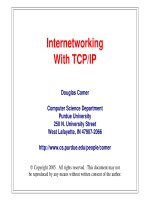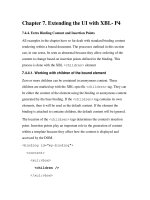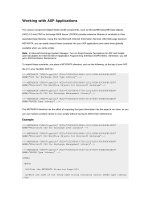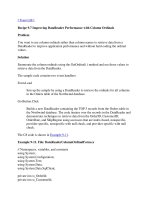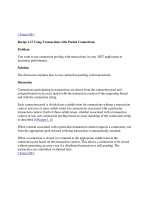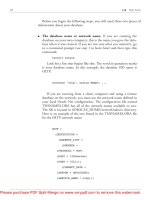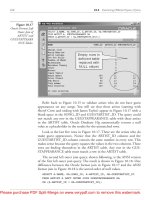Internetworking with TCP/IP- P64 ppt
Bạn đang xem bản rút gọn của tài liệu. Xem và tải ngay bản đầy đủ của tài liệu tại đây (506.15 KB, 10 trang )
Sec.
32.1
1
Required Security Algorithms
589
32.1 2 Secure Sockets
By the mid 1990s when it became evident that security was important for Internet
commerce, several groups proposed security mechanisms for use with the Web.
Although not formally adopted by the
IETF, one of the proposals has become a de facto
standard.
Known as the
Secure Sockets Layer (SSL),
the technology was originally developed
by Netscape, Inc. As the name implies, SSL resides at the same layer as the socket
API. When a client uses SSL to contact a server, the SSL protocol allows each side to
authenticate itself to the other. The two sides then negotiate to select an encryption al-
gorithm that they both support. Finally, SSL allows the two sides to establish an en-
crypted connection
(i.e., a connection that uses the chosen encryption algorithm to
guarantee privacy).
32.13 Firewalls And Internet Access
Mechanisms that control
internet access
handle the problem of screening a particu-
lar network or an organization from unwanted communication. Such mechanisms can
help prevent outsiders from: obtaining information, changing information, or disrupting
communication on
an
organization's intranet. Successful access control requires a care-
ful combination of restrictions on network topology, intemlediate information staging,
and packet filters.
A single technique known as
an
intemetjirewallt,
has emerged as the basis for in-
ternet access control.
An
organization places a firewall at its connection to external net-
works (e.g., the global Internet). A firewall partitions
an
internet into two regions, re-
ferred to infom~ally as the
inside
and
outside.
32.14 Multiple Connections And Weakest Links
Although concept seems simple, details complicate firewall construction. First, an
organization's intranet can have multiple external connections. The organization must
form a
securiq perimeter
by installing a fuewall at each external connection. To
guarantee that the perimeter is effective, all fuewalls must
be
configured to use exactly
the same access restrictions. Otherwise, it may
be
possible to circumvent the restric-
tions imposed by one firewall by entering the organization's internet through another$.
We can summarize:
An organization that has multiple exteml connections must install a
jirewall on each exteml connection and must coordinate all
jirewalls. Failure to restrict access identically on all firewalls can
leave the organization vulnerable.
+The termfirewall is derived from building architecture in which a firewall is a thick, fireproof partition
that makes a section of a building impenetrable to fire.
$The well-known idea that security is only as strong as the weakest point has been termed the weakest
link
uxiorn
in reference to the adage that a chain is only as strong as
its
weakest link.
590
Internet
Security
And
Fiewall
Design
(Psec)
Chap.
32
32.1
5
Firewall Implementation
How should a firewall be implemented? In theory, a fxewall simply blocks all
unauthorized communication between computers in the organization and computers out-
side the organization.
In
practice, the details depend on the network technology, the
capacity of the connection, the traffic load, and the organization's policies. Thus, no
single solution works for all organizations; building an effective, customized
firewall
can be difficult.
To operate at network speeds, a
fxewall must have hardware and software optim-
ized for the task. Fortunately, most commercial routers include a high-speed filtering
mechanism that can be used to perform much of the necessary work.
A
manager can
configure the filter in a router to request that the router block specified datagrams. As
we discuss the details of filter mechanisms, we will see how filters form the basic build-
ing blocks of a fuewall. Later we will see how filters can be used in conjunction with
another mechanism to provide communication that is safe, but flexible.
32.1
6
Packet-Level Filters
Many commercial routers offer a mechanism that augments normal routing and
permits a manager to further control packet processing. Informally called a
packet
filter,
the mechanism requires the manager to specify how the router should dispose of
each datagram. For example, the manager might choose to
filter
(i.e. block) all
da-
tagrams that come from a particular source or those used by a particular application,
while choosing to route other datagrarns to their destination.
The term
packet filter
arises because the filtering mechanism does not keep a
record of interaction or a history of previous datagrams. Instead, the filter considers
each datagram separately. When a datagram first arrives, the router passes the datagram
through its packet filter before performing any other processing.
If
the filter rejects the
datagram, the router drops it immediately.
Because TCPDP does not dictate a standard for packet filters, each router vendor is
free to choose the capabilities of their packet filter as well as the interface a manager
uses to configure the filter. Some routers pennit a manager to configure separate filter
actions for each interface, while others have a single configuration for all interfaces.
Usually, when
specifying
datagrams that the filter should block, a manager can list any
combination of source
IP
address, destination
IP
address, protocol, source protocol port
number, and destination protocol port number. For example, Figure 32.6 illustrates a
filter specification.
In the example, the manager has chosen to block incoming datagrams destined for
a few well-known services and to block one case of outgoing datagrams. The filter
blocks all outgoing datagrarns that originate from any host address matching the 16-bit
prefix of 128.5.0.0 that
are
destined for a remote e-mail server (TCP port
25).
The filter
also blocks incoming datagrarns destined for
FTP
(TCP port 21), TELNET (TCP port
23), WHOIS (UDP port 43), TFTP (UDP port 69), or FINGER (TCP port 79).
Sec.
32.16
Packet-Level Filters
OUTSIDE
2
R
1
INSIDE
ARRIVES ON
INTERFACE
2
2
1
2
2
2
I
P
SOURCE
*
*
128.5.0.0 I1
6
*
*
*
I P
DEST.
*
SOURCE
PROTOCOL PORT
TCP
*
TCP
*
TCP
*
UDP
*
UDP
*
TCP
DEST.
PORT
21
23
25
43
69
79
Figure
32.6
A
router with two interfaces and
an
example
datagram
filter
specification.
A
router that includes a packet filter forms the
basic building block of a fmwall.
32.17
Security And Packet Filter Specification
Although the example filter configuration in Figure
32.6
specifies a small list of
services that should
be
blocked, such an approach does not work well for an effective
firewall.
There are three reasons. Fist, the number of well-known ports is large and
growing rapidly. Thus, listing each service requires a manager to update the list con-
tinually; an error of omission can leave the fuewall vulnerable. Second, much of the
traffic on an internet does not travel to or from a well-known port.
In
addition to pro-
grammers who can choose port numbers for their private client-server applications, ser-
vices like
Remote Procedure
Call
(RPC)
assign ports dynamically.
Third,
listing ports
of well-known services leaves the firewall vulnerable to
tunneling.
Tunneling can cir-
cumvent security
if
a host or router on the inside agrees to accept encapsulated
da-
tagrams from
an
outsider, remove one layer of encapsulation, and forward the datagram
on to the service that would otherwise
be
restricted by the fuewall.
How can a firewall use a packet filter effectively? The answer lies in reversing the
idea of a filter: instead of specifying the datagrams that should be filtered, a firewall
should
be
configured to block all datagrams except those destined for specific networks,
hosts, and protocol ports for which external communication has been approved. Thus, a
manager begins with the assumption that communication is not allowed, and then must
examine the organization's information policy carefully before enabling any port.
In
fact, many packet filters allow a manager to spec@ a set of datagrams to admit instead
of a set of datagrams to block. We can summarize:
Internet Security
And
FiewaU
Design
(TF'sec)
Chap.
32
To be effective, a firewall that uses datagram filtering should restrict
access to all
ZP
sources,
ZP
destinations, protocols, and protocol ports
except those computers, networks, and services the organization expli-
citly decides to make available
externally.
A
packet filter that allows
a manager to specify which datagrams to admit instead of which da-
tagrarns to block can make such restrictions easy to speczfy.
32.1
8
The Consequence
Of
Restricted Access For Clients
A
blanket prohibition on datagrams arriving for an unknown protocol port seems to
solve many potential security problems by preventing outsiders from accessing arbitrary
servers in the organization. Such a
firewall has an interesting consequence: it also
prevents an arbitrary computer inside the
firewall from becoming a client that accesses a
service outside the
firewall. To understand why, recall that although each server
operates at a well-known port, a client does not. When a client program begins execu-
tion, it requests the operating system to select a protocol port number that is neither
among the well-known ports nor currently in use on the client's computer. When it at-
tempts to communicate with
a
server outside the organization, a client will generate one
or more datagrams and send them to the server. Each outgoing datagram has the
client's protocol port as the source port and the server's well-known protocol port as the
destination port. The
firewall will not block such datagrams as they leave. When it
generates a response, the server reverses the protocol ports. The client's port becomes
the destination port and the server's port becomes the source port. When the datagram
carrying the response reaches the firewall, however, it will be blocked because the desti-
nation port is not approved. Thus, we can see
an
important idea:
If
an organization's firewall restricts incoming datagrams except for
ports that correspond to services the organization makes available
externally, an arbitrary application inside the organization cannot be-
come
a
client of a server outside the organization.
32.19 Proxy Access Through A Firewall
Of course, not all organizations configure their firewalls to block all datagrams
destined for unknown protocol ports.
In
cases where a secure fuewall is needed to
prevent unwanted access, however, users on the inside need a safe mechanism that pro-
vides access to services outside. That mechanism forms the second major piece of
fuewall architecture.
In general, an organization can only provide safe access to outside services through
a secure computer. Instead of trying to make
all
computer systems in the organization
secure (a daunting task), an organization usually associates one secure computer with
Sec.
32.19
Proxy Access Through A Fiewall
593
each f~ewall, and installs a set of application gateways on that computer. Because the
computer must be strongly fortified to serve as a secure communication channel, it is
often called a
bastion host.
Figure
32.7
illustrates the concept.
Bastion Host
P-
]
manually enabled
bypass
INTRANET
(INSIDE)
Figure
32.7
The conceptual organization of a bastion host embedded in a
firewall. The bastion host provides secure access to outside ser-
vices without requiring an organization to admit datagram with
arbitrary
destinations.
As the figure shows, the firewall has two conceptual barriers. The outer barrier
blocks all incoming traffic except
(1)
datagrams destined for services on the bastion
host that the organization chooses to make available externally, and
(2)
datagrams des-
tined for clients on the bastion host. The inner barrier blocks incoming traffic except
datagram that originate on the bastion host.
Most
firewalls also include a
manual
bypass
that enables managers to temporarily pass some or all traffic between a host in-
side the organization and a host outside (e.g., for testing or debugging the network).
To understand how a bastion host operates, consider Web access. Because the
fuewall prevents the user's computer from receiving incoming datagram, the user can-
not use a browser for direct access. Instead, the organization arranges a proxy server on
the bastion host. Inside the organization, each browser is configured to use the proxy.
Whenever a user selects a link or enters a
URL,
their browser contacts the proxy. The
proxy contacts the server, obtains the specified page, and then delivers it internally.
32.20
The Details
Of
Firewall Architecture
Now that we understand the basic fuewall concept, the implementation should ap-
pear
straightforward. Conceptually, each of the baniers shown in Figure
32.7
requires a
router that has a packet filter?. Networks interconnect the routers and a bastion host.
For example, an organization that connects to the global Internet might choose to imple-
ment a firewall as Figure
32.8
shows.
?Some organizations use
a
one-amzedfirewall
configuration in which
a
single physical router implements
all the functionality.
594
Internet
Security
And
Fiewall
Design
(IPsec)
Chap.
32
Connection to
global Internet
bastion host
H
Figure
32.8
A
firewall implemented with two routers and a bastion host. One
of the routers has a connection to the rest of the Internet.
As the figure shows, router
R,
implements the outer barrier; it filters all traffic ex-
cept datagrams destined for the bastion host,
H.
Router
R,
implements the inner barrier
that isolates the rest of the corporate intranet from outsiders; it blocks all incoming da-
tagrams except those that originate on the bastion host.
Of course, the safety of an entire fuewall depends on the safety of the bastion host.
If an intruder can gain access to the computer system running on the bastion host, they
will gain access to the entire inside internet. Moreover, an intruder can exploit security
flaws
in
either the operating system on the bastion host or the network applications it
runs. Thus, managers must be particularly careful when choosing and configuring
software for a bastion host. In summary:
Although a bastion host is essential for communication through a
firewall, the security of the firewall depends on the safety of the bas-
tion host. An intruder who exploits a
securityflaw in the bastion host
operating system can gain access to hosts inside the firewall.
32.21
Stub
Network
It may seem that Figure
32.8
contains a superfluous network that connects the two
routers and the bastion host. Such a network is often called a
stub network
because it is
small (i.e., stubby). The question arises, "Is the stub network necessary or could a site
place the bastion host on one of its production networks?" The answer depends on the
traffic expected from the outside. The stub network isolates the organization from
in-
coming datagram traffic.
In
particular, because router
R,
admits all datagrams destined
for the bastion host, an outsider can send an arbitrary number of such datagrams across
Sec.
32.21
Stub Network
595
the stub network.
If
an external connection is slow relative to the capacity of a stub
network, a separate physical wire may
be
unnecessary. However, a stub network is usu-
ally an inexpensive way for an organization to protect itself against disruption of service
on an internal production network.
32.22
An Alternative Firewall Implementation
The fuewall implementation in Figure
32.8
works well for an organization that has
a single serial connection to the rest of the global Internet. Some sites have a different
interconnection topology. For example, suppose a company has three or four large cus-
tomers who each need to deposit or extract large volumes of information. The company
wishes to have a single fmwall, but allow connections to multiple
sitest. Figure
32.9
illustrates one possible fuewall architecture that accommodates multiple external con-
nections.
bastion
host
-
Figure
32.9
An
alternative fuewall architecture that
permits
multiple external
connections through a single fmwall. Using one firewall for
multiple
connections can reduce the cost.
As the figure shows, the alternative architecture extends a firewall by providing an
outer network at which external connections terminate. Router
R,
acts
as
in Figure
32.8
to protect the site by restricting incoming datagrams to those sent from the bastion host.
Routers
R,
through
R,
each connect one external site to the fmwall.
To understand why fuewalls with multiple connections often use a router per con-
nection, recall that all sites mistrust one another. That is, the organization running the
firewall does not trust any of the external organizations completely, and none of the
external organizations trust one another completely. The packet filter in a router on a
given external connection can
be
configured to restrict traffic on that particular connec-
tion. As a result, the owner of the firewall can guarantee that although all external con-
nections share a single, common network, no
datagram
from one external connection
will pass to another. Thus, the organization running the fuewall can assure customers
that it is safe to connect. To summarize:
?A
single fuewall can
be
less expensive
and
easier to administrate than
a
separate
f~ewall per connection.
Internet
Security
And
Fiewall
Design
(IPsec)
Chap.
32
When multiple external sites connect through a single firewall, an ar-
chitecture that has a router per external connection can prevent
unwanted packet Pow from one external site to another.
32.23 Monitoring And Logging
Monitoring is one of the most important aspects of a firewall design. The network
manager responsible for a firewall needs to
be
aware of attempts to bypass security.
Unless a firewall reports incidents, a manager may be unaware of problems.
Monitoring can be
active
or
passive.
In active monitoring, a firewall notifies a
manager whenever an incident occurs. The chief advantage of active monitoring is
speed
-
a manager finds out about a potential problem immediately. The chief disad-
vantage is that active monitors often produce so much information that a manager can-
not comprehend it or notice problems. Thus, most managers prefer passive monitoring,
or a combination of passive monitoring with a few high-risk incidents also reported by
an active monitor.
In passive monitoring, a
firewall logs a record of each incident in a file on disk. A
passive monitor usually records information about normal traffic
(e.g., simple statistics)
as well as datagrams that are filtered. A manager can access the log at any time; most
managers use a computer program. The chief advantage of passive monitoring arises
from its record of events
-
a manager can consult the log to observe trends and when a
security problem does occur, review the history of events that led to the problem. More
important, a manager can analyze the log periodically (e.g., daily) to determine whether
attempts to access the organization increase or decrease over time.
32.24
Summary
Security problems arise because an internet can co~ect organizations that do not
have mutual trust. Several technologies are available to help ensure that information
remains secure when being sent across an internet. IPsec allows a user to choose
between two basic schemes: one that provides authentication of the datagram and one
that provides authentication plus privacy. IPsec modifies a datagram either by inserting
an Authentication Header or by using an Encapsulating Security Payload, which inserts
a header and trailer and encrypts the data being sent. IPsec provides a general frame-
work that allows each pair of communicating entities to choose an encryption algorithm.
Because security is often used with tunneling (e.g., in a
VPN),
IPsec defines a secure
tunnel mode.
The firewall mechanism is used to control internet access.
An
organization places
a firewall at each external connection to guarantee that the organization's intranet
remains free from unauthorized traffic. A
firewall consists of two barriers and a secure
computer called a bastion host. Each barrier uses a packet filter to restrict datagram
traffk. The bastion host offers externally-visible servers, and runs proxy servers that al-
Sec.
32.24
Summary
597
low users to access outside servers. The filters are configured according to the
organization's information policy. Usually, the fuewall blocks all datagrams arriving
from external sources except those datagrams destined for the bastion host.
A
firewall can be implemented
in
one of several ways; the choice depends on de-
tails
such
as
the number of external connections. In many cases, each barrier in a
firewall is implemented with a router that contains a packet filter. A firewall can also
use a stub network to keep external traffic off an organization's production networks.
FOR FURTHER STUDY
In
the mid 1990s, the IETF announced a major emphasis on security, and required
each working group to consider the security implications of its designs. Consequently,
many RFCs address issues of internet security and propose policies, procedures, and
mechanisms.
Kent and
Atkinson [RFC 24011 defines the IPsec architecture. Kent and
Atkinson [RFC 24021 specifies the IPsec authentication header, and [RFC 24061 speci-
fies the encapsulating security payload.
Many RFCs describe security for particular application protocols. For example,
Wijnen et. al. [RFC 25751 presents the view-based security and Blurnenthal and Wijnen
[RFC
25741 presents a user-based security model, both are intended for use with
SNMPv3.
Cheswick and Bellovin [I9941 discusses firewalls and other topics related to the
secure operation of TCP/IF' internets. Kohl and Neuman
[RFC
15101 describes the ker-
beros authentication service, and Borman
[RFC
141 11 discusses how kerberos can be
used to authenticate TELNET.
EXERCISES
Many sites that use a bastion host arrange for software to scan all incoming files before
admitting them to the organization. Why do organizations scan files?
Read the description of a packet filter for a commercially available router. What
features does it offer?
Collect a log of
all
tr&c entering your site. Analyze the log to determine the percen-
tage of traffic that arrives from or is destined to a well-known protocol
port.
Do the
results surprise you?
If
encryption software is available on your computer, measure the time required to en-
crypt a
10
Mbyte file, transfer it to another computer, and decrypt it. Compare the result
to the time required for the transfer if no encryption is used.
Survey users at your site to determine
if
they send sensitive information in e-mail. Are
users aware that SMTP transfers messages in ASCII, and that anyone watching network
traffic can see the contents of an e-mail message?
598 Internet
Security And
Fiewall
Design
(IPsec)
Chap.
32
32.6
Survey employees at your site to find out how many use modems and personal comput-
ers to import or export information. Ask if they understand the organization's informa-
tion policy.
32.7
Can a fuewall be used with other protocol suites such as AppleTalk or Netware? Why
or why not?
32.8
Can a firewall
be
combined with NAT? What
are
the consequences?
32.9
The
military
only releases information to those who "need to know." Will such a
scheme work for all information in your organization? Why or why not?
32.10
Give two reasons why the group of people who administer an organization's security
policies should be separate from the group of people who administer the organization's
computer and network systems.
32.11
Some organizations use fuewalls to isolate groups of users internally. Give examples of
ways that internal firewalls can improve network performance and examples of ways
internal firewalls can degrade network performance.
32.12
If
your organization uses IPsec, find out which algorithms are being used. What is the
key size?
